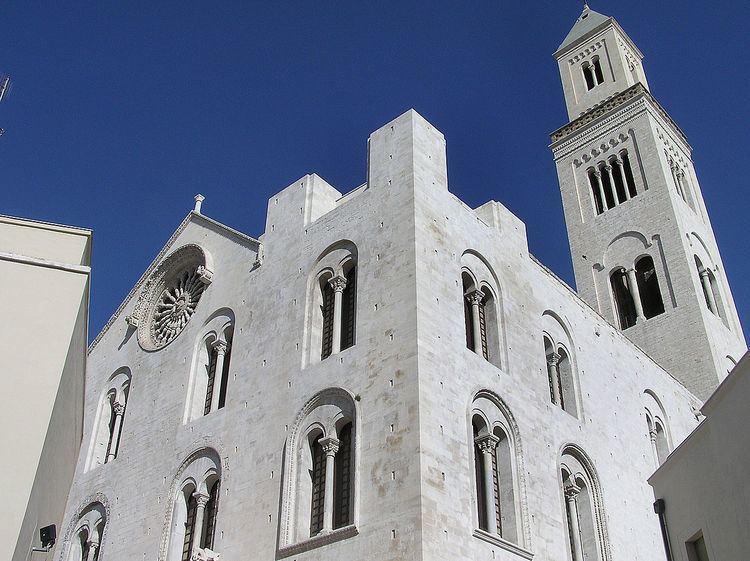Established 4th Century Phone +39 080 528 8111 Country Italy Cathedral Bari Cathedral | Parishes 125 Area 1,264 km² Province Province of Bari Archbishop Francesco Cacucci | |
 | ||
Population- Total- Catholics (as of 2006)740,900732,277 (98.8%) Address Largo S. Sabino, 70122 Bari, Italy Similar Basilica San Nicola, Parrocchia San Marcello, Parrocchia San Giuseppe, Parrocchia Santuario Santa Fara, Parrocchia Preziosis Sangue i | ||
The archdiocese of Bari-Bitonto (Latin: Archidioecesis Barensis-Bituntinus) is a Roman Catholic ecclesiastical territory in Apulia, southern Italy, created in 1986, when the historical archdiocese of Bari was united to the diocese of Bitonto.
Contents
History
The first known bishop of Bari was Gervasius, who, in 347, was at the Council of Sardica. In 530 bishop Peter held the title of Metropolitan under Epiphanius, bishop of Constantinople & Ecumenical Patriarch. In 780 bishop Leontius was present at the Seventh Ecumenical Council, the Second of Nicaea.
In the ninth century the Saracens laid waste Apulia, destroyed the city of Canosa (Canusium) and captured Bari. In 841, however, the Byzantine army reconquered Bari, and in 844 bishop Angelarius, Canosa, then in ruins, brought to Bari the relics of Saint Rufinus, Saint Memorus, and Saint Sabinus, which he had rescued from the ruins. Pope Sergius II conferred on him the title of Bishop of the two dioceses of Bari and Canosa, a title which the archbishops of Bari retain to the present.
In 933 Pope John XI granted the bishops of Bari the use of the pallium. It seems that the bishops were dependent on the Eastern Ecumenical Patriarch until the 10th century. Giovanni II (952) was able to withdraw from this influence, refusing to accept the prescriptions of the patriarch concerning liturgical points. All connection with the Eastern Churches was finally severed during the eleventh century, as Bari became a direct ecclesiastical dependency of Rome. So before the 10th c was over, the top ranking Orthodox episcopal dignitary throughout Byzantine Italy, became the archbishop of Melfi, in spite of Bari remaining the center of Byzantine authority in the area, as the seat of the katepano of Italia until the capture of the city by the Normans in 1071.
Ironically the archbishop of Bari that irreversibly distanced his see from Byzantium, was Bisanzio/Byzantius (1025), who obtained from the pope the privilege of consecrating his suffragans. He also began the construction of the new cathedral, which was continued by his successors, Nicolo (1035), Andreas (1062), and Elias (1089) of the Benedictine Order.
By contrast to Bisanzio's Catholicism affections, Andreas, the archbishop from 1062 to at least 1066, kept an eye to the roots of his Faith, for example journeying to Constantinople, and at some point even converting to Judaism. Archbishop Andreas then fled to Muslim-dominated Egypt, where he eventually died in 1078.
Remarkably, the next archbishop Urso (1080–1089) was captured by the Muslim forces and converted to Islam.
Other archbishops were:
In 1087 some Bari sailors, on their return from the East, brought with them the relics of Saint Nicholas, bishop of Myra, for which Roger Borsa, the Norman duke of Apulia, built a church, the Basilica of San Nicola; this became the object of interfaith veneration and of multinational pilgrimages.
In the reorganization of the dioceses of the Kingdom of Naples, at the beginning of the nineteenth century, the diocese of Bitetto was suppressed and made a part of the Diocese of Bari. The suffragan sees under Bari historically were: the diocese of Conversano, diocese of Ruvo, and diocese of Bitonto.
Sufragan sees
Diocese of Bari
Erected: 4th Century
Latin Name: Barensis
Archdiocese of Bari (-Canosa)
Elevated: 6th Century to Metropolitan See
Latin Name: Barensis (-Canusinus)
since 1800
Archdiocese of Bari-Bitonto
30 September 1986 United with the Diocese of Bitonto to form the Archdiocese of Bari-Bitonto
Latin Name: Barensis-Bituntinus
Books
Acknowledgment
This article incorporates text from a publication now in the public domain: Herbermann, Charles, ed. (1913). "Bari". Catholic Encyclopedia. New York: Robert Appleton.
